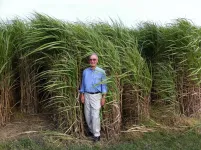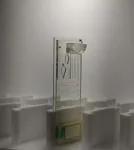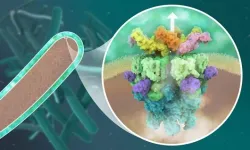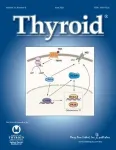(Press-News.org) A new electrode that could free up 20% more light from organic light-emitting diodes has been developed at the University of Michigan. It could help extend the battery life of smartphones and laptops, or make next-gen televisions and displays much more energy efficient.
The approach prevents light from being trapped in the light-emitting part of an OLED, enabling OLEDs to maintain brightness while using less power. In addition, the electrode is easy to fit into existing processes for making OLED displays and light fixtures.
"With our approach, you can do it all in the same vacuum chamber," said L. Jay Guo, U-M professor of electrical and computer engineering and corresponding author of the study.
Unless engineers take action, about 80% of the light produced by an OLED gets trapped inside the device. It does this due to an effect known as waveguiding. Essentially, the light rays that don't come out of the device at an angle close to perpendicular get reflected back and guided sideways through the device. They end up lost inside the OLED.
A good portion of the lost light is simply trapped between the two electrodes on either side of the light-emitter. One of the biggest offenders is the transparent electrode that stands between the light-emitting material and the glass, typically made of indium tin oxide (ITO). In a lab device, you can see trapped light shooting out the sides rather than traveling through to the viewer.
"Untreated, it is the strongest waveguiding layer in the OLED," Guo said. "We want to address the root cause of the problem."
By swapping out the ITO for a layer of silver just five nanometers thick, deposited on a seed layer of copper, Guo's team maintained the electrode function while eliminating the waveguiding problem in the OLED layers altogether.
"Industry may be able to liberate more than 40% of the light, in part by trading the conventional indium tin oxide electrodes for our nanoscale layer of transparent silver," said Changyeong Jeong, first author and a Ph.D. candidate in electrical and computer engineering.
This benefit is tricky to see, though, in a relatively simple lab device. Even though light is no longer guided in the OLED stack, that freed-up light can still be reflected from the glass. In industry, engineers have ways of reducing that reflection--creating bumps on the glass surface, or adding grid patterns or particles that will scatter the light throughout the glass.
"Some researchers were able to free up about 34% of the light by using unconventional materials with special emission directions or patterning structures," Jeong said.
In order to prove that they had eliminated the waveguiding in the light-emitter, Guo's team had to stop the light trapping by the glass, too. They did this with an experimental set-up using a liquid that had the same index of refraction as glass, so-called index-matching fluid--an oil in this case. That "index-matching" prevents the reflection that happens at the boundary between high-index glass and low-index air.
Once they'd done this, they could look at their experimental set-up from the side and see whether any light was coming sideways. They found that the edge of the light-emitting layer was almost completely dark. In turn, the light coming through the glass was about 20% brighter.
The finding is described in the journal Science Advances, in a paper titled, "Tackling light trapping in organic light-emitting diodes by complete elimination of waveguide modes."
This research was funded by Zenithnano Technology, a company that Guo co-founded to commercialize his lab's inventions of transparent, flexible metal electrodes for displays and touchscreens.
The University of Michigan has filed for patent protection.
The device was built in the Lurie Nanofabrication Facility.
INFORMATION:
Guo group
DOI: 10.1126/sciadv.abg0355
More corn is grown in the United States than any other crop, but we only use a small part of the plant for food and fuel production; once people have harvested the kernels, the inedible leaves, stalks and cobs are left over. If this plant matter, called corn stover, could be efficiently fermented into ethanol the way corn kernels are, stover could be a large-scale, renewable source of fuel.
"Stover is produced in huge amounts, on the scale of petroleum," said Whitehead Institute Member and Massachusetts Institute of Technology (MIT) biology professor Gerald Fink. "But there are enormous technical challenges to using them cheaply to create biofuels and other important chemicals."
And so, year after year, most of the woody corn material is left in the fields to rot.
Now, a ...
DURHAM, N.C. - Biomedical engineers at Duke University have demonstrated a tablet-sized device that can reliably detect multiple COVID-19 antibodies and biomarkers simultaneously.
Initial results show the test can distinguish between antibodies produced in response to SARS-CoV-2 and four other coronaviruses with 100% accuracy.
The researchers are now working to see if the easy-to-use, energy-independent, point-of-care device can be used to predict the severity of a COVID-19 infection or a person's immunity against variants of the virus.
Having also recently shown the same "D4 assay" platform can detect Ebola infections a day earlier than the gold standard polymerase chain reaction (PCR) test, the researchers say the results show how flexible the technology can be to adapt to other ...
CAMBRIDGE, MA - Boosting production of biofuels such as ethanol could be an important step toward reducing global consumption of fossil fuels. However, ethanol production is limited in large part by its reliance on corn, which isn't grown in large enough quantities to make up a significant portion of U.S. fuel needs.
To try to expand biofuels' potential impact, a team of MIT engineers has now found a way to expand the use of a wider range of nonfood feedstocks to produce such fuels. At the moment, feedstocks such as straw and woody plants are difficult to use for biofuel production because they first need to be broken down to fermentable sugars, a process that releases numerous byproducts that are toxic to yeast, the microbes most commonly used to produce biofuels.
The ...
Tuberculosis is one of the top ten causes of death worldwide, infecting about one-quarter of the world's population. Although it is treatable, the rise of multidrug-resistant tuberculosis poses a major threat to global health security, and has been declared by the World Health Organization as a global health emergency. Reduced access to diagnosis and treatment during the COVID-19 pandemic is expected to dramatically increase the number of tuberculosis infections. This will set global efforts to tackle the disease back several years.
Tuberculosis is caused by infection with Mycobacterium tuberculosis: a bacterium that infects human lungs and other organs by using complex molecular ...
When Winter Storm Uri hit, many Texans lost power from February 14-20, resulting in losses of lives and economic activity, and damages to their homes that for some are still not completely repaired. Now, four months later as demand for electricity has increased at the start of the summer amid tight supply, Texans continue to prioritize improvements to the power grid, albeit with doubt as to whether the Texas Legislature and Governor can get the job done.
In a survey by the Hobby School of Public Affairs and UH Energy at the University of Houston fielded between May 13-24, 1,500 individuals in Texas aged 18 and older responded to a series of questions regarding their experience during Winter Storm Uri and their evaluation ...
BOSTON - At the recent 2021 Annual Scientific Sessions of the American Diabetes Association, researchers from Massachusetts General Hospital (MGH) presented positive updates on their trials of the bacillus Calmette-Guérin (BCG) vaccine to safely and significantly lower blood sugars.
In type 1 diabetes, an autoimmune disease which currently has no cure, T cells attack the pancreas and destroy its ability to create insulin, a hormone vital in allowing glucose to enter cells to produce energy. In prior work, Denise Faustman, MD, PhD, director ...
A new study by UC Davis researchers confirms the low likelihood that SARS-CoV-2 contamination on hospital surfaces is infectious. END ...
Scientists from the University of Michigan have developed an innovative way to use NASA satellite data to track the movement of tiny pieces of plastic in the ocean.
Microplastics form when plastic trash in the ocean breaks down from the sun's rays and the motion of ocean waves. These small flecks of plastic are harmful to marine organisms and ecosystems. Microplastics can be carried hundreds or thousands of miles away from the source by ocean currents, making it difficult to track and remove them. Currently, the main source of information about the location ...
New Rochelle, NY, June 24, 2021—The American Thyroid Association, the European Association of Nuclear Medicine, the European Thyroid Association, and the Society of Nuclear Medicine and Molecular Imaging released a joint statement on three key topics addressing controversies in thyroid cancer care. The joint statement is published in the peer-reviewed journal Thyroid®, the official journal of the American Thyroid Association® (ATA®).Click here to read the statement now.
An inter-societal working group addressed the current controversies and evolving concepts in three main areas: peri-operative risk stratification; the role of diagnostic radioactive iodine ...
Toronto, ON - Despite research showing associations between anabolic steroid use and criminal offending, the possibility of a similar association between legal performance-enhancing substance use, such as creatine, and criminal offending remained unknown. A new study published online in the journal Drug and Alcohol Dependence now shows that both forms of performance-enhancing substance use is longitudinally associated with criminal offending among U.S. adults.
The study, which analyzed a sample of over 9,000 U.S. participants from the National Longitudinal Study ...




